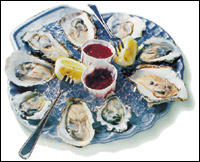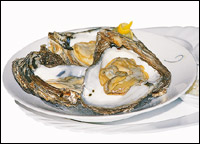


 Aphrodite's Aphrodisiac
Aphrodite's AphrodisiacAre oysters truly the world�s most reliable aphrodisiacs? They must be because of their high zinc content. But that�s not the only reason why they find themselves on the menus of most fine wining and dining restaurants of the world, discovers SERGEI MALIK. |
|
EVEN before they came to be recognised as an exotic, gourmet food and were added onto seafood menus in fine wining and dining restaurants, oysters have been believed to be a powerful aphrodisiac. The legendary lover Casanova is said to have consumed up to 60 oysters a day. And Aphrodite, the Greek Goddess of love, sprang from the sea on an oyster shell and gave birth to Eros.
However, scientifically, the true aphrodisiac capacity of an oyster really depends on the dopamine content which influences sexual desire. Zinc is the most common nutritional deficiency in men with fertility problems and since oysters have the highest zinc content among all foods, they do a good job of replacing the lost zinc needed to improve male fertility.
Apart from having a high zinc content, oysters are the richest animal source of vitamins and minerals. This makes the oyster a highly nutritious food and it is very low in calories too!
Oysters can be classified into two basically recognised species, the ostrea edulis and crassostrea gigi. Ostrea are mostly the native oysters whereas crassostrea are the oysters cultivated artificially in a particular area.
The native oysters can be recognised by their pale, roundish shells and a very shallow bottom shell. They are ideal for cooking as their meat has plenty of flavour. Oyster species have a lot of varieties, as the smallest change in location or the turn of the tide can affect a change in the quality, flavour, size and shape of the oyster.
Oysters need a lot of attention. They require to be turned continuously between tides to allow the live molluscs inside the shells to move freely and to help them grow to a reasonable size.
The best place to find plump and juicy oysters is the place where the river meets the sea. This is because the water in this area is warm and the rich algae on which oysters thrive can be found in abundance.
Opening an oyster without hurting yourself is a task in itself. The oyster shells are often rugged and crinkly and can cut the hand if a cloth does not guard it. To open an oyster, wrap your left hand in a towel. Place the oyster cup-side down with its hinge facing you. Insert an oyster knife into the hinge and pry it while passing the knife under the top shell to cut the muscle. Slide the knife along the length to open the oyster fully. Retain the juice which is also called the love potion or liquor.
What makes the oyster so expensive is that apart from the expense of the modern techniques used in oyster production, it also includes the expense of transportation. Oysters are mostly cultivated in farms in warm-water hatcheries. The native oysters are considered the creme de la creme of oysters. While buying oysters, see to it that the shells are tightly shut. A fresh oyster always uses the top and bottom muscles to hold the shell securely closed. A shelled oyster should be plump and sweet smelling and the liquor or the love potion should always be clear and should be drunk.
A native oyster is the gourmet�s delight. When you indulge in a treat of native oysters, eat them as they are. Eating an oyster au naturel will remind you of a dip in the ocean - natural, exciting, refreshing and shocking.
|

Home Page
About the mag
Subscribe
Advertise
Contact Us
 There is an old adage - �You should only eat oysters when there is an �r� in the month�. This refers to ostrea edulis, because this species spawns between May and August and are generally not very plump and fleshy during this time of the year. Winter months are the best time to buy native oyster whereas crassostrea oysters do not spawn in their shells and so they are available throughout the year.
There is an old adage - �You should only eat oysters when there is an �r� in the month�. This refers to ostrea edulis, because this species spawns between May and August and are generally not very plump and fleshy during this time of the year. Winter months are the best time to buy native oyster whereas crassostrea oysters do not spawn in their shells and so they are available throughout the year.